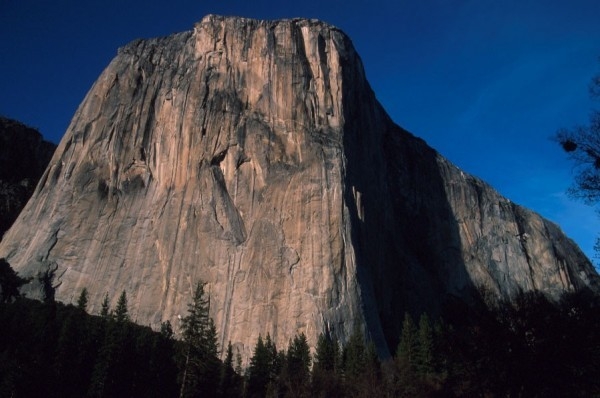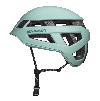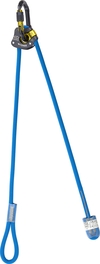The greatest challenge when traveling to Yosemite Valley is deciding what to climb. When you enter the Valley you are overwhelmed with fantastic-looking rock in all sizes, from the one-pitch climbs at the cookie climb to the 30+ pitch mega-routes on El Capitan. So, how do you choose what to climb with only a limited amount of time?
The answer is simple: look for the classics.
The definition of "classic," however, is not that easy. Allen Steck and Steve Roper had to wrestle with the questions, "What makes a route classic?" when they wrote Fifty Classic Climbs of North America. They found that classic routes usually met three criteria (listed in order of importance):
1) offer excellent climbing
2) the peak or route should look striking from afar and
3) should have a significant climbing history.
While I agree with these three criteria, my rule for what constitutes classic is even simpler: classic routes are those few climbs that you want to climb again and again and again.
| Route |
Grade
|
Length
|
Beauty
|
| Bishop's Terrace |
5.8
|
60m
|
|
|
This is often called "The best 5.8 hand crack in Yosemite Valley." The climbing consists of glorious hand jams, a brief wide section and double cracks. For some, Bishop's Terrace will be a crowning climb of their Yosemite trip while for others this climb will represent a great introduction into harder Yosemite cracks.
|
| East Buttress |
IV 5.10b
|
500m
|
|
|
The thought of climbing El Capitan conjures fear, doubt and excitement. The East Buttress of El Capitan has the potential to spawn all these emotions with far less commitment than a Grade VI nail-up. The route is a good step up in difficulty from the East Buttress of Middle Cathedral. Many pitches have amazing exposure-some relatively easy and others relatively hard-providing an up-close example of the awesome presence of El Cap. These combined qualities will give the climber a well-deserved sense of accomplishment upon completion.
|
| Regular Northwest Face |
VI 5.9 C1
|
600m
|
|
|
Because of the long approach and north-facing orientation, the Regular Route has an Alpine quality not found on other popular Yosemite walls. The climbing starts off wandering at a low angle and gradually grows steeper and gets better. The last seven pitches are spectacular.
|
| Royal Arches |
III 5.10b o 5.7 A0
|
500m
|
|
With the major Valley spires climbed, the pioneers of the 30's turned to the unclimbed faces. Climbing Half Dome and El Capitan was unthinkable. The 1400-foot Royal Arches, however, was covered with just enough features and ledges to forge a route.While the first part followed large, 4th class ledges, the upper half of the route looked more challenging.
|
| Sacherer Cracker |
5.10a
|
50m
|
|
An excellent, clean, widening crack up a steep wall, Sacherer Cracker is a beautiful climb. Bomber protection for the crux and the first 100 feet of climbing leads to a 10-foot widening offwidth, which is the actual crux for many. Don't underestimate the short 5.7 approach pitch, which is a polished flare that has spit out many a 5.11 climber!
|
|
While there are thousands of routes in Yosemite, relatively few meet either of the criteria above. To help climbers identify classic climbs I have listed over 100 classic routes on my SuperTopo web site. Even this list, however, can be daunting to the traveling climber with only a week or two of holiday. So I have listed five classic climbs above that should not be missed. I have started with an easy single-pitch climb and listed progressively harder climbs all the way up to a multi-day big wall. For each climb I have provided both history and a description of what makes this climb special.
To get even more history and beta on these climbs, as well as a detailed SuperTopo, visit www.supertopo.com. While these climbs are not necessarily the "five best climbs in Yosemite," they are archetypal classic climbs that capture both the rich history and fantastic rock of the Valley. A SuperTopo for all these routes is available in the SuperTopo ebook, Yosemite Ultra Classics.
Yosemite details:
Yosemite Valley has all the good and bad that comes with an urban destination. The good news is that if your car breaks down or you’re craving filet mignon, Yosemite has you covered. The bad news is that it is hard to escape the car traffic and tourists. The Valley is relatively empty from November to April but unfortunately most long routes will be unclimbable during these months.
For the most detailed topos for these routes, check out the “Yosemite Ultra Classics” guide from SuperTopo.com. Each route comes with a detailed topo, route history by Steve Roper and a strategy section.
Many climbs require an Alpine start to avoid the crowds. Of the routes covered here, only Royal Arches has enough variations to enable easily passing slower parties. The best time to climb these routes is in the spring and fall. About the only time Royal Arches does not have crowds is in the winter and early spring when much of the route runs with water. The wet rock is not bad if you remember this key bit of advice: take off your shoes to get better friction.
During the summer, you will have to start at dawn to avoid the heat, especially on the Cathedral Spires and Nutcracker. If the Valley is sweltering, consider heading to a great swimming hole about 10 miles west of the Highway120 entrance station. You can choose whether to jump off the 15-foot or the 25-foot cliff. Check out www.supertopo.com for directions to get here and other swimming holes.
Other rest day activities include filling up the cooler, renting a raft from Curry Village and floating down the Merced River. Or just head down to El Cap Meadow with a pair of binoculars and either watch climbers or pick out the next new squeeze job (there are still a few 50-foot sections of unclimbed rock).
If you arrive in Yosemite in the summer, chances are Camp 4 will be full. If you are having trouble getting a site, consider camping next to the Merced River west of El Portal or at any of the other park entrance stations. There is also more information on extra camping at www.supertopo.com/climbingareas/yosemite.html
Best time of year
Yosemite has some of the best weather of any climbing area in the United States. Because the climbs start from elevations between 2800-7500 feet, there is usually some place with good climbing temperatures throughout the year. Spring and fall have the best climbing weather. Summer cragging is usually uncomfortably hot but the long routes can be cool enough. Winter can have good climbing weather but can also have months of uniquely wet and severe Sierra storms. A dry November is our favorite time in Yosemite - perfect temps in the sun and no crowds.
Weather
November – March: The Valley empties of both climbers and tourists, which brings a pristine feeling to both the climbs and Yosemite in general. During this time there is usually an even mixture of clear and stormy days. Most of the long routes at higher elevations are too wet or cold, but there are many sunny and dry cragging areas, mainly west of the Highways 140/120 junction in Lower Merced Canyon. When bad weather rolls in, things get nasty real quick. Pacific storms usually bring three days of heavy snow or rain but can last up to a week or longer. Usually it only takes a day for most sunny crags to dry out after a storm. If a two-week storm system rolls in, it's time to ski or snowboard at Badger Pass in Yosemite or head to Joshua Tree. If camping in the Valley during the winter, prepare for long cold nights.
April – May 15: Walls and the Valley are still uncrowded. It's warmer, but there is the same 50/50 chance of getting either good or miserable weather. If you are traveling from far away this is a risky time to visit, especially with a week or less of vacation. Most of the long climbs are still too wet or cold, but the crags are dry.
May 1– June: Perfect weather and big crowds of both tourists and climbers. Long days make this a great time to do a lengthy multi-pitch route.
July – August: The Valley is still crowded with tourists, but the climbs are uncrowded as most people head to Tuolumne for cooler weather. While Valley floor temperatures are often in the 90s and 100s, temperatures on the walls 500 feet above the Valley are usually comfortable in the 70s and low 80s. Prepare for the heat with plenty of extra water.
September – October: The Valley is crowded with tourists and climbers. The weather is generally perfect except for the occasional lingering heat wave. The first winter storm usually arrives in late October or early November.
Rock
At first, Yosemite climbs feel weird and insecure. They demand strength and technique not easily acquired at your local gym or crag. The slick, glacier-polished rock has few handholds. Instead, you jam your hands and feet in cracks and smear your feet on, well, sometimes on nothing. There is more balance and subtlety involved than brute strength. When your natural instinct is to grab and pull, often you need to relax and balance.
Bibliography
Camp 4 - Steve Roper's definitive book on Yosemite climbing history from the beginning to 1970. A must read.
Defying Gravity - This book is less personal and authoritative than Camp 4 but covers a broader period of time and has more photos.
El Capitan - Dan Duane picks a handful of Yosemite personalities and explores what made them tick. Well written.
North American Classic Climbs - A celebration of the finest classic climbs on the continent.
Yosemite Big Wall Obscurities - This free download includes hand drawn topo of obscure Yosemite big walls.
About the author
Climbing Magazine once computed that three percent of Chris McNamara’s life on earth has been spent on the face of El Capitan—an accomplishment that has left friends and family pondering Chris’ sanity. He’s climbed El Capitan over 50 times and holds five big wall speed climbing records. In 1998 Chris did the first Girdle Traverse of El Capitan, an epic 75-pitch route that begs the question, “Why?”
Outside Magazine has called Chris one of “the world’s finest aid climbers.” He’s the winner of the 1999 Bates Award from the American Alpine Club and founder of the American Safe Climbing Association, a nonprofit group that has replaced over 5000 dangerous anchor bolts. He is a graduate of UC Berkeley and serves on the board of the ASCA, Yosemite National Institutes, and Rowell Legacy Committee.

 1 / 4
1 / 4 Chris McNamara
Chris McNamara



 Copia link
Copia link
























